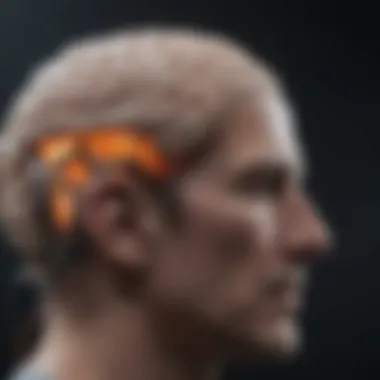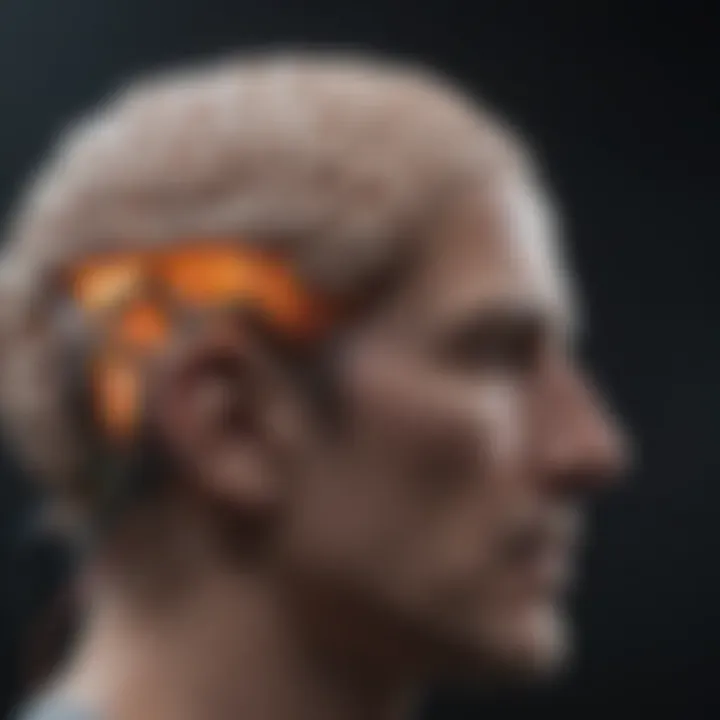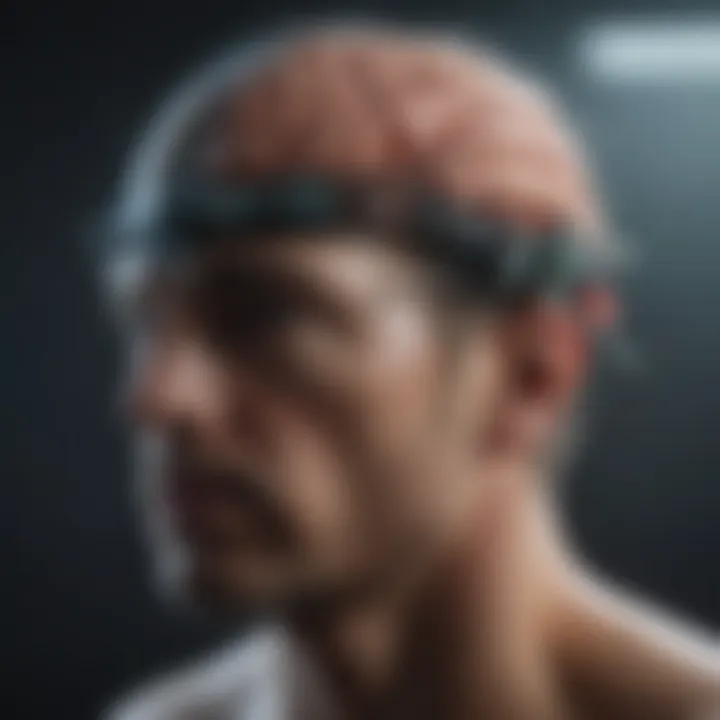Understanding Brain Sensing: Mechanisms and Future Directions


Intro
Brain sensing has emerged as a groundbreaking area of study within neuroscience, merging biological insights with advanced technological capabilities. The exploration of this field reveals the intricate mechanisms that govern neural activity and the potential applications of brain sensing technologies that extend well beyond basic research. As researchers previously focused on understanding individual components of neural networks, brain sensing allows for an integrated view of cognitive and biological processes. This article aims to examine the core mechanisms of brain sensing, its applications in various domains, and the ethical considerations that arise with these advancements.
Article Overview
Purpose of the Article
The primary goal of this article is to provide an in-depth analysis of brain sensing and its implications in neuroscience. By understanding how brain sensing works, we can begin to appreciate its potential to revolutionize both research and clinical practices. This article will elucidate the mechanisms underlying brain sensing, showcasing its relevance across diverse disciplines, including medicine, psychology, and artificial intelligence.
Relevance to Multiple Disciplines
Brain sensing serves as a crucial intersection point for several academic and professional fields. Its applications in medical diagnostics, treatment strategies, and cognitive enhancement blur traditional boundaries between disciplines. Understanding the principles of brain sensing is essential not only for neuroscientists but also for healthcare professionals, ethicists, and technologists. For instance, the development of brain-computer interfaces utilizes insights from neuroscience, engineering, and computer science to create systems allowing direct communication between the human brain and machines.
Research Background
Historical Context
Historically, the study of neural activity was limited to invasive and often dangerous methods. Techniques such as autopsies and later, electroencephalograms (EEGs), provided initial insights into brain function. Over time, advancements in imaging technologies, like functional magnetic resonance imaging (fMRI), have revolutionized our understanding of how brain regions communicate during different cognitive tasks. As a result, the landscape of neuroscience has evolved, paving the way for innovative brain sensing technologies.
Key Concepts and Definitions
Understanding brain sensing requires familiarity with several key concepts:
- Brain-Computer Interface (BCI): A direct communication pathway established between the brain and an external device, allowing users to control computers using their thoughts.
- Neuroimaging: Non-invasive techniques used to visualize brain activity and structure, including fMRI and PET scans.
- Electroencephalography (EEG): A method for recording electrical activity of the brain via electrodes placed on the scalp.
These concepts form the backbone of brain sensing. They provide the framework for discussing its mechanisms and applications in the subsequent sections of the article.
Brain sensing technologies are not merely tools; they represent the convergence of biology and technology, unlocking new frontiers in understanding the brain.
Brain sensing technologies are not merely tools; they represent the convergence of biology and technology, unlocking new frontiers in understanding the brain.
Foreword to Brain Sensing
Brain sensing is an emerging field that integrates neuroscience and technology to monitor and interpret brain activity. Understanding this topic is paramount not only due to its scientific significance but also for its practical applications in both clinical settings and research environments. As the tools for brain sensing evolve, so does our comprehension of cognitive processes, neurological disorders, and human behavior.
This exploration emphasizes the mechanisms behind brain sensing technologies, delineating how they function and their relevance in real-world scenarios. Brain sensing extends beyond merely observing brain activity; it facilitates a deeper understanding that can lead to innovative applications. This progresses the field of neuroscience, contributing to enhanced diagnostic capabilities, targeted therapies, and improved quality of life for individuals with neurological conditions.
The study of brain sensing considers various factors, including the types of data collected, the technologies employed, and the ethical implications of such advancements. Without appreciating these facets, one cannot grasp the full potential and limitations inherent in current practices. By studying both technological progress and historical context, philosophers, researchers, and practitioners are better prepared to engage with the future landscape of neuroscience.
Defining Brain Sensing
Brain sensing refers to the collection and analysis of data that reflects the activity within the brain. This activity can range from electrical impulses that neurons transmit to the blood flow changes observed in different brain regions during cognitive tasks. The critical aspect of brain sensing is its ability to convert raw neural signals into comprehensible information, which can then be analyzed and interpreted.
Techniques such as Electroencephalography (EEG) and functional Magnetic Resonance Imaging (fMRI) form the backbone of this field. EEG captures electrical activity through electrodes placed on the scalp, allowing for real-time monitoring of brain waves. In contrast, fMRI provides insights into blood flow and brain activity by detecting changes in the magnetic properties of brain regions. Collectively, these methods reveal patterns associated with various mental and emotional states.
Historical Context
The concept of brain sensing is not entirely new. Its roots can be traced back to early neurological and physiological studies, where scientists attempted to correlate brain activity with mental functions. The invention of the EEG in the early 20th century marked a significant milestone. Hans Berger's discovery that electrical activity could be recorded from the scalp set the stage for subsequent advancements.
Throughout the decades, the development of imaging technologies has dramatically changed how we perceive brain function. The advent of fMRI in the 1990s allowed researchers to visualize brain activity in ways that were previously unimaginable. These advances opened a new realm of possibilities for studying cognitive processes, mental disorders, and the effects of various interventions.
"The history of brain sensing illustrates a continuous drive toward understanding the complexities of the human mind through technological innovation."
"The history of brain sensing illustrates a continuous drive toward understanding the complexities of the human mind through technological innovation."
In summary, the historical context of brain sensing is integral to its current applications and future trajectory. By knowing where the field began, one gains a better perspective on its future directions and the challenges that lie ahead.


Mechanisms of Brain Sensing
Understanding the mechanisms of brain sensing is fundamental to comprehending how these technologies function. The effectiveness of brain sensing hinges on precise data collection and interpretation. Several methods have been developed to monitor neural activity, each with its own strengths and limitations. Exploring these mechanisms helps clarify how brain sensing shapes the understanding of cognitive processes and neurological conditions.
Neural Activity Monitoring
Neural activity monitoring is key to brain sensing. This involves observing the electrical or metabolic activity of neurons. The insights gained can inform us about brain functions, reactions to stimuli, and even the progression of mental health conditions. Following neural pathways can help decode complex behaviors and emotional responses. As a result, it is a pivotal focus in both clinical diagnostics and cognitive research. Techniques for monitoring neural activity can range from invasive to non-invasive approaches, each selected based on specific needs.
Technological Advances in Sensing
Technological evolution has played a crucial role in brain sensing. The following technologies stand out in this sphere:
Electroencephalography (EEG)
Electroencephalography measures electrical activity in the brain using electrodes placed on the scalp. This method offers real-time data and is non-invasive, which is a major advantage for studies involving subjects over extended periods. One significant feature is its high temporal resolution, which allows researchers to monitor brain activity in milliseconds. EEG is popular for clinical use due to its relatively low cost and ease of setup. However, it is limited in spatial accuracy, meaning it can only provide a general idea of where in the brain the activity occurs.
Functional Magnetic Resonance Imaging (fMRI)
Functional Magnetic Resonance Imaging detects brain activity by measuring changes in blood flow. This method provides detailed images of brain structures and functions. The key characteristic of fMRI is its high spatial resolution, allowing for precise localization of brain activity. It is a beneficial choice for understanding complex brain functions during specific tasks. Nevertheless, fMRI has limitations in terms of temporal resolution, as it may take seconds to accumulate data, rather than milliseconds, making it less suitable for studying rapid cognitive processes.
Magnetoencephalography (MEG)
Magnetoencephalography measures the magnetic fields produced by neuronal activity. It combines the advantages of both EEG and fMRI, offering excellent temporal and spatial resolution. MEG is particularly useful for mapping brain functions related to sensory processing and motor responses. A unique feature is its ability to monitor brain activity without the interference of the skull or tissue. However, MEG systems are complex and costly, which can limit their widespread use in both research and clinical settings.
Data Acquisition and Processing
Data acquisition and processing is another critical aspect of brain sensing. The collected data must be processed accurately to make sense of neural signals. This phase often involves using sophisticated algorithms and statistical methods to extract meaningful information from raw data. Proper processing allows for the interpretation of brain activity patterns, enhancing our understanding of cognition and its disorders. Techniques used in data processing include Fourier transforms, machine learning, and advanced visualizations.
Applications of Brain Sensing
The applications of brain sensing technologies are diverse and increasingly vital in both clinical and research settings. Understanding these applications helps us recognize the transformative potential of these technologies in improving mental health and advancing neuroscience. Brain sensing applications demonstrate practical relevance, thus bridging theory and practice in the field. The clinical applications have significant implications for patient care, while research applications foster deeper insights into cognitive processes.
Clinical Applications
Neurological Disorders
Neurological disorders, such as epilepsy, Parkinson’s disease, and multiple sclerosis, highlight the clinical applications of brain sensing. These conditions necessitate effective monitoring and treatment strategies. Brain sensing technologies provide critical data that can inform diagnosis and optimize treatment protocols. Neuroimaging techniques like MRI or EEG are key in capturing neural activity associated with these disorders.
A prominent feature of these disorders is their variability in symptoms, which can change over time or differ from patient to patient. This makes regular monitoring essential and emphasizes the utility of brain sensing methodologies.
Advantages of incorporating brain sensing in this context include:
- Enhanced understanding of disorder-specific neural dynamics.
- Data-driven approaches to tailor interventions improving patient outcomes.
- Support for neuroscience research into the mechanisms driving these disorders.
However, there are challenges too. Data interpretation can be complex and requires continuous advancements in analytical techniques.
Neurofeedback and Rehabilitation
Neurofeedback represents a unique aspect of rehabilitation that utilizes brain sensing technology to provide real-time feedback to individuals. This feedback often aims at promoting better self-regulation of mental states in conditions such as ADHD or anxiety disorders. It has gained traction as a valuable tool in therapeutic settings. The advantage of this approach is its non-invasive nature, allowing individuals to engage in training without the discomfort of surgical interventions.
The unique selling point of neurofeedback is its potential for empowering patients. They learn to modify their brain activity towards desired states, fostering self-efficacy and motivation in managing their conditions. This application is beneficial because:
- Reduces dependence on pharmacological interventions.
- Enhances cognitive function and emotional regulation.
On the downside, neurofeedback requires careful calibration and personalization. Results can vary significantly between patients, necessitating tailored training protocols.
Research Applications
Cognitive Neuroscience Studies


Cognitive neuroscience relies heavily on brain sensing technologies to explore the relationship between brain function and cognitive processes. Techniques like fMRI and EEG are essential for uncovering how different brain regions contribute to activities like perception, decision-making, and memory.
What makes cognitive neuroscience studies appealing is their interdisciplinary nature. They draw from psychology, neuroscience, and technology. This melding invites a rich exploration of how we understand the mind. This approach applies quantitative methods while still respecting individual variability in cognitive experiences.
Advantages of applying brain sensing in cognitive studies include:
- Ability to explore real-time brain dynamics during cognitive tasks.
- Insights into brain connectivity and its impact on function.
Nonetheless, these studies face challenges, primarily in data interpretation. The complexity of human cognition can lead to ambiguous results, requiring innovative analytical methods.
Brain-Computer Interfaces (BCI)
Brain-computer interfaces (BCI) exemplify a leading edge of brain sensing technology, enabling direct communication between the brain and external devices. BCIs are primarily used in assistive technologies for individuals with disabilities, allowing them to control devices through thought alone. This is particularly crucial for those with mobility impairments.
A key characteristic of BCIs is their capacity to translate neural signals into actionable commands. This holds significant promise for improving quality of life by enhancing independence. For many users, the ability to perform tasks that would otherwise be impossible profoundly affects their daily experiences.
The advantages of BCIs are substantial:
- Enhance communication for users unable to speak.
- Support control of prosthetic limbs, increasing autonomy.
However, existing BCIs face hurdles such as limited accuracy and a steep learning curve for users. Continuous research is essential to overcoming these challenges and making BCIs more user-friendly.
"The integration of brain sensing technologies into practical applications emphasizes the importance of these innovations in advancing our understanding and capabilities within both clinical and research contexts."
"The integration of brain sensing technologies into practical applications emphasizes the importance of these innovations in advancing our understanding and capabilities within both clinical and research contexts."
Challenges in Brain Sensing
The advancement of brain sensing technologies presents significant promises, but it is essential to address the challenges faced in this rapidly evolving field. These challenges can hinder progress in research, development, and clinical application. Understanding these challenges is critical for both practitioners and researchers in order to develop effective solutions and safeguard ethical standards. The key elements at play include technical limitations and the complexities of data interpretation.
Technical Limitations
Brain sensing technologies are limited by several technical issues. One of the primary concerns is the resolution of the data collected. For example, techniques like Electroencephalography (EEG) offer broad insights into brain activity, yet they struggle to pinpoint the precise location of neural activity. This limitation may arise from the lack of spatial resolution, which is crucial for understanding complex brain functions.
Another technical hurdle is the interference from noise. Environmental and biological noise can obscure brain signals, leading to inaccurate readings. Factors such as muscle activity or external electromagnetic signals can distort the data obtained, which complicates the analysis.
Furthermore, the portability and user-friendliness of brain sensing devices are still under development. Many of the sophisticated devices are bulky and require specialized training to operate. This lack of accessibility limits their use in various settings, including remote locations where neurological conditions need monitoring. It is vital to create devices that are more adaptable and easier for both professionals and patients.
Interpretation of Data
The interpretation of data gathered through brain sensing technologies poses another significant challenge. The complexity of brain activity means that the data generated can be vast and multi-dimensional. This complexity demands sophisticated analytical methods and high-level expertise to extract meaningful insights. Numerous studies have shown that improper interpretation of data can lead to misleading conclusions, which can adversely affect clinical decisions.
Additionally, there is a risk of overfitting models to the data, especially in machine learning applications. Overfitting occurs when a model learns patterns that are too specific to the training data, making it less effective on new, unseen data. This issue adds to the necessity for rigorous validation procedures to ensure that the models used for interpretation yield reliable results.
“The intricacies of brain data interpretation require a strong interdisciplinary approach, integrating knowledge from neuroscience, data science, and ethics.”
“The intricacies of brain data interpretation require a strong interdisciplinary approach, integrating knowledge from neuroscience, data science, and ethics.”
Another significant concern is the potential for bias in data interpretation. If training data sets are not diverse or representative of the wider population, the outcomes may not be generalizable. Ensuring variety in data sets is crucial to minimize bias and enhance the accuracy of interpretations.
Ethical Considerations in Brain Sensing
The field of brain sensing, while replete with technological advancements and scientific discoveries, is equally fraught with ethical dilemmas. These ethical considerations must be taken seriously as they can dictate the trajectory of research and applications in this area. Understanding these issues is crucial not only for practitioners and researchers but also for the public and policymakers. A comprehensive grasp of ethical concerns promotes responsible innovations that do not compromise individual rights or societal norms.
Brain sensing technologies have the potential to offer profound insights into human thoughts and emotions. This capability, however, raises significant ethical questions about privacy, autonomy, and consent. It is essential to address these concerns to ensure that the benefits of brain sensing are realized without infringing on basic human rights.
Privacy Concerns
Privacy is one of the foremost ethical issues associated with brain sensing. As brain sensing technologies advance, they allow for the collection of highly sensitive data. This data can reveal thoughts, intentions, and emotional states. The potential for misuse of this information is alarming. For instance, if data from brain sensing were to be accessed by unauthorized entities, it could lead to violations of personal privacy on a large scale.


Researchers and developers need to implement robust security measures to protect sensitive information. Some of the key areas to consider include:
- Data Encryption: Ensuring that data collected through brain sensing is stored securely and encrypted to prevent unauthorized access.
- Access Control: Establishing strict guidelines on who can access brain data and under what circumstances can be limiting.
- Regular Audits: Conducting continuous evaluations of data security protocols can help identify vulnerabilities.
"The fusion of technology and biology in brain sensing presents both unprecedented opportunities and substantial risks. It is the responsibility of the scientific community to navigate these challenges thoughtfully."
"The fusion of technology and biology in brain sensing presents both unprecedented opportunities and substantial risks. It is the responsibility of the scientific community to navigate these challenges thoughtfully."
Implications for Consent
In the realm of brain sensing, obtaining informed consent is not just a best practice; it is a fundamental ethical obligation. Participants must fully understand what they are consenting to when taking part in studies involving brain sensing technologies. Informed consent should encompass the following elements:
- Clear Explanation of Risks: Potential risks associated with participation must be clearly communicated. Participants should understand any physical, psychological, or social risks involved.
- Purpose of Data Collection: Clearly articulating why data is being collected and how it will be used fosters transparency.
- Right to Withdraw: Individuals must have the right to withdraw their consent at any point without facing negative consequences.
The complexities of brain data collection can make it challenging for participants to grasp all aspects of their involvement. Researchers must find ways to present information clearly and concisely, minimizing technical jargon that could confuse participants. Educating participants and ensuring they are sufficiently informed is crucial for ethical integrity.
By addressing privacy and consent, the field of brain sensing can cultivate trust with individuals and communities, laying the groundwork for innovations that respect human dignity while enhancing scientific understanding.
Future Directions in Brain Sensing
The field of brain sensing is rapidly evolving, pushing the boundaries of neuroscience and technology. As innovations emerge, the importance of future directions in this realm becomes increasingly pronounced. These advancements promise not only to enhance our understanding of the brain but also to improve clinical outcomes and broaden research horizons. Exploring this subject reveals key elements such as innovative technologies and interdisciplinary collaboration, both of which are essential for realizing the full potential of brain sensing.
Innovative Technologies on the Horizon
Research in brain sensing is witnessing a surge of innovative technologies. Some of the most notable advancements include:
- Portable Brain Imaging Devices: Recent developments focus on creating lightweight and portable devices for brain imaging. These devices could allow for real-time monitoring of brain activity in various settings, providing unprecedented insights into neural processes.
- Advanced Neurofeedback Systems: The next generation of neurofeedback systems promises enhanced precision and adaptability. These systems could lead to more effective rehabilitation therapies for neurological conditions, optimizing treatment outcomes.
- Wearable Brain Sensors: Integration of sensors in wearable technology is an area of significant growth. Future iterations promise to monitor brain activity and provide continuous data, enhancing our understanding of daily cognitive performance and stress responses.
Such innovations are vital not only for advancing research but also for translating findings into practical applications. The benefits of these technologies are far-reaching, from clinical diagnostics to everyday health monitoring.
Interdisciplinary Collaborations
The future of brain sensing relies heavily on interdisciplinary collaborations. Bringing together expertise from various fields can accelerate the development of innovative solutions. Areas of collaboration include:
- Neuroscience and Engineering: Engineers and neuroscientists are working together to design new imaging techniques and devices that offer better resolution and functionality.
- Artificial Intelligence and Machine Learning: Incorporating AI in data processing and analysis enhances the capabilities of brain sensing systems. Machine learning models can identify patterns in large datasets, aiding in the interpretation of complex neural signals.
- Psychology and Social Sciences: Collaborating with psychologists allows researchers to understand the psychological implications of brain data, ensuring that the advancements in technology align with human behavior and social contexts.
These interdisciplinary partnerships are crucial for fostering an integrated approach to brain sensing. By combining knowledge and resources, researchers can generate insights that are both comprehensive and transformative.
Collaboration across various fields optimizes innovation, driving the evolution of brain sensing technologies.
Collaboration across various fields optimizes innovation, driving the evolution of brain sensing technologies.
In summary, the future directions in brain sensing encapsulate a dynamic interplay of technology and collaboration. The focus on innovative tools and interdisciplinary teamwork is set to elevate the understanding and application of brain sensing in significant ways.
Finale
The conclusion serves as a vital element in summarizing the comprehensive exploration of brain sensing presented in this article. It encapsulates the essential insights derived from the previous sections, synthesizing the various mechanisms, applications, and ethical considerations discussed. By drawing connections between these facets, the conclusion not only reinforces the significance of brain sensing in modern neuroscience but also highlights its transformative potential across diverse contexts.
Summary of Key Insights
In reviewing the key insights, it becomes apparent that brain sensing technologies, such as electroencephalography (EEG) and functional magnetic resonance imaging (fMRI), have dramatically advanced our understanding of brain activity. These methodologies allow for detailed analysis of neural patterns, facilitating significant strides in clinical applications like diagnosing and treating neurological disorders.
Moreover, the insights into research applications, particularly through cognitive neuroscience studies and brain-computer interfaces, demonstrate the potential to bridge the gap between theory and practical application.
"With the rapid development of innovative technologies, brain sensing is reshaping how we understand and interact with our neural processes."
"With the rapid development of innovative technologies, brain sensing is reshaping how we understand and interact with our neural processes."
This article also emphasizes challenges in technical implementation and data interpretation, stressing the importance of robust methodological frameworks in effective research and development. Lastly, ethical considerations surrounding privacy and consent underscore the responsibility that comes with harnessing brain sensing technologies, ensuring that advancements benefit society in a thoughtful manner.
Final Thoughts on the Future of Brain Sensing
Looking ahead, the future of brain sensing appears promising yet complex. Emerging technologies are likely to revolutionize both the approach to understanding brain functions and the applications stemming from these insights. Interdisciplinary collaborations will play a crucial role in driving innovation, blending expertise from fields such as neurology, engineering, and computer science.
As we continue to explore the intricacies of the human brain, it is imperative that we remain vigilant about ethical issues that arise. Privacy, consent, and data security will be pivotal as brain sensing technologies become more integrated into healthcare and personal use. By maintaining a balanced perspective, we can harness the full potential of brain sensing, ensuring it serves to enhance human life in ethical and beneficial ways.



